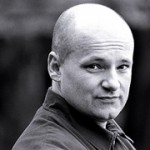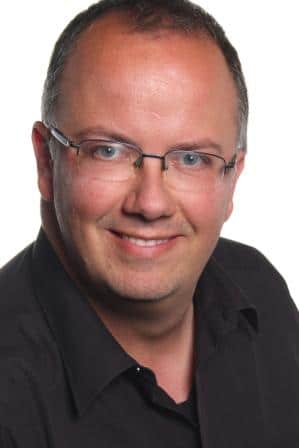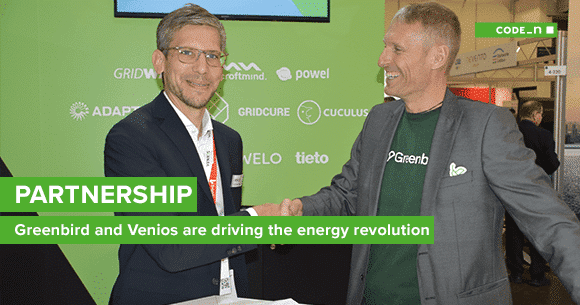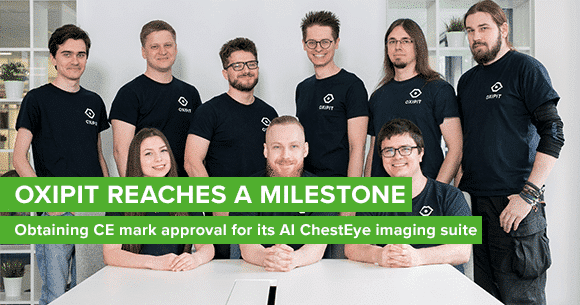HARALD TAGLINGER: “The innovations of the past few years were actually just small steps”HARALD TAGLINGER: “Die Innovationen der vergangenen Jahre waren eigentlich nur kleine Schritte”
Harald Taglinger in a digital conversation with blogger Oliver Gassner on Apple’s secret of success, creative work in the cloud and the future of our mobile life.
Oliver Gassner: Hello Harald.
Harald Taglinger: Hello Oliver.
OG: Can you first just tell us a bit about yourself?
HT: My name is Harald Taglinger (http://taglinger.de), I live in Zurich and work as a communications manager and author. I’ve been online since 1987. My company
(Citrix) works throughout the EMEA (Europe, Middle East, Africa) and I work on the move quite a lot. Partly because my company office is 50 kilometers away in Schaffhausen.
OG: What was the key web or mobile discovery for you over the past 12 months?
HT: In general: the cloud. Cloud computing in connection with an iPhone, so I can use my time on the road for some preliminary work.
OG: Anything specific, where you could say: I use that every day and it’s changed the way I work or think?
HT: Three examples.
- My “computer” is just a virtual desktop now (XenDesktop helps a lot here) which I log onto at one of my two offices or via iPhone when I’m traveling. It means I can carry on working on projects wherever I am. It doesn’t make any difference which machine I’m using. Sometimes, I’ll interrupt my work and catch a train to finish it off because I’m just not
getting the idea I’m looking for at that particular location. Evernote. Sketches, texts, photos can come from anywhere. Evernote gives me the possibility to capture them and automatically sync with my main device to carry on working with them. Sometimes, when I’m on the move, I’ll sort things out using Skype before they land in Evernote. - I can now work creatively wherever I am at that particular moment. I can even edit music and video right on my iPhone in the same way as I can on the Mac at my home studio. None of my projects are now created at a single location. The data simply follow me around.
To sum up then: computing is no longer restricted to one specific device. It’s always there.
Just as it happened with email. And I guess I don’t need to mention Facebook etc. here.
OG: What’s the difference between a good idea and a genuine innovation?
HT: Innovation changes the rules, the processes. An invention, on the other hand, is a good idea which doesn’t have a direct impact on real effects. An innovation has the power to translate new technology into new processes and new ways of working.
OG: What determines whether a good idea will become a successful business proposition?
HT: First of all, “successful” doesn’t always have to mean “financially successful”. The innovations of the past few years – and this is where Apple is so brilliant – were actually just small steps which made existing technology accessible for the masses. The iPhone would have been a flop in the 50s, for example. Even with the same possibilities. There was no
need for that level of mobile data access.
Harald Taglinger im digitalen Gespräch mit Blogger Oliver Gassner zu Apples Erfolgsgeheimis, kreativem Arbeiten in der Cloud und zum mobilen Leben der Zukunft.
Harald Taglinger: Hallo Oliver.
OG: Stellst du dich bitte kurz vor?
HT: Mein Name ist (http://taglinger.de/), ich lebe in Zürich und arbeite als Communications Manager und Autor. Bin seit 1987 online. Die Arbeit in meinem Unternehmen (Citrix) erstreckt sich über EMEA (Europe, Middle East, Africa), und ich arbeite viel von unterwegs. Sei es nur, weil mein Firmenoffice 50 Kilometer entfernt in Schaffhausen liegt.
OG: Was ist für Dich die Web- oder Mobile-Entdeckung der vergangenen 12 Monate?
HT: Generell: Die Wolke. Cloudcomputing in Verbindung mit einem iPhone, damit ich die Zeit unterwegs für erste Arbeiten nutzen kann.
OG: Irgendetwas Konkretes, wo du sagst: Das benutze ich täglich und verändert die Art, wie ich arbeite oder denke?
HT: Drei Beispiele.
- Mein “Computer” ist nur noch ein virtuelles Desktop (XenDesktop hilft hier ungemein), an dem ich mich an einem meiner beiden Arbeitsplätze oder auch unterwegs via iPhone anmelde. So arbeite ich an Projekten weiter, egal wo ich bin. Es macht keinen Unterschied, auf welcher Maschine. Manchmal unterbreche ich die Arbeit und setze mich in den Zug, um fertig zu arbeiten, weil mir eine Idee an dem einen Ort noch nicht kommt.
- Evernote. Skizzen, Texte, Fotos entstehen überall. Mit Evernote habe ich die Möglichkeit, die einzufangen und dann sofort durch einen Abgleich auf meinem Basisgerät zu haben und weiter daran zu arbeiten. Manchmal kläre ich auch mobil via Skype Dinge ab, bevor sie in Evernote landen.
- Kreative Arbeiten entstehen inzwischen komplett ortsunabhängig. Selbst Musik und Video schneide ich am iPhone genauso wie auf meinem MAC, wenn ich im Homestudio sitze. Kein Projekt entsteht mehr an nur einem Ort. Die Daten wandern einfach mit.
Zusammenfassend: Computing ist geräteunabhängig geworden. Es ist immer da. So, wie das schon mit Mails der Fall war. Facebook etc. brauche ich hier ja nicht extra zu erwähnen.
OG: Was unterscheidet eine gute Idee von einer echten Innovation?
HT: Innovation ändert die Regeln, die Prozesse. Eine Invention hingegen ist eine gute Idee, die aber keinen direkten Impact auf reale Effekte hat. Innovation hat die Kraft, neue Technik in neue Prozesse und damit neue Arbeitsweisen umzusetzen.
HT: Innovation is constantly progressing, but in SMALL STEPS. The art is in selling these small steps as new eras. Take Steve Jobs, for example. The tablet is actually nothing new, we already had the stylus PC as well as the iPhone with multitouch and gestures. There wasn’t even any new software on it. It was just small steps – brilliantly communicated – which made
the iPad an innovation and the dominant market device.
HT: “O snail, climb Mount Fuji, but slowly!” as they say.
OG: Why do most of the world’s most successful web and mobile applications at the moment originate in the USA – and so few in Europe?
HT: Scale of market. However good an idea is in Switzerland, there are only 3 million potential customers in that language. In the USA, there are 300 million. Once a product has gained momentum on a market, like Facebook, I can then roll it out worldwide. But always using the waterfall principle, based on the size of the markets.
OG: Who do you see as the most creative people in the web and mobile sector at present. And why?
HT: There are some nice projects like “Amen”, which implement very simple, good ideas but have little chance of commercial success. I guess Apple is still the leader in mobile communications. Microsoft and Nokia are bringing up the rear right now, lagging behind somewhat. Google+ has potential but is falling into the me-too trap, looking too much at Facebook (the Circle idea isn’t ready yet). Facebook itself, by the way, hasn’t really grasped the innovation cycle yet. It doesn’t have the same pulse as Apple. The interface desperately needs revamping.
HT: Otherwise, I’ve always really liked Doodle. But that’s not new any more and simply had the charm of being brilliantly simple.
OG: OK, but the question was more about people. Does your answer mean you think only teams or large corporations are “really” creative at the moment?
HT: In such a complex environment as digital media, it’s virtually impossible for individuals to produce complete innovations. I think it’s a popular myth to credit the corporate patriarchs, such as Gates (Microsoft), Jobs (Apple), Page/Brin (Google) etc., with their companies’ products. It may help them to sell emotions, but the departure of Jobs will prove that one person alone may be able to create a culture, but can’t take on everything himself or delegate everything.
OG: What do you personally require to be creative?
HT: Freedom. In all its forms.
OG: In what way will future mobility be different from its current form?
HT: Let me be a little pessimistic here. A high degree of mobility also requires a high level of private transport. And in view of the imminent energy crises, standards are bound to change with regard to how often people can travel. That’s why I guess we should be talking about how virtual structures are going to be and how often we meet virtually. And that will be
from a fixed location. In other words, the exact opposite of what people are currently preaching as the ideal world.
OG: Are you prepared to make a prediction as to what the next big thing will be on the net?
HT: The display as hardware. I’ve been waiting years (you can always hope) for Steve Jobs to turn round before he leaves the stage and say one more thing” and then point to his glasses. “By the way, following the iPhone we now want to launch iGlasses. Amazing.” To some extent, all mobile concepts ultimately suffer from the fact that we can’t take a 21-inch screen on
the train with us. As the consequence of all IT interfaces, I can imagine a kind of projection onto the iris in combination with technology already offered by Microsoft’s “kinekt”. The surface moves into the eye and fuses with your surroundings as a kind of “headover display” which allows interaction.
OG: Looking back for a moment: to what extent does your current mobile life differ from your “pre-mobile” life 15 or 20 years ago?
HT: In 1993, I had a laptop with modem and Datex-J account to do my mobile banking. The laptop battery lasted about 90 minutes and Datex-J couldn’t really be used on the analogue phone lines in Leipzig or Berlin. There was no common standard for files, there was hardly any information online, and email hadn’t established itself yet. That’s all very different today. The media matrix is now complete: I can create, send and open text, pictures, sound, graphics and video whenever I want. That’s a form of compression which nobody imagined in the 90s, which is simply taken for granted. The content cloud which surrounds me every day couldn’t have been created in a week in the 90s, let alone distributed or even received. “More” doesn’t necessarily mean “better”, but “more integrated” is definitively “better”. And that’s fantastic. In our everyday digital lives there are hardly any showstoppers any more. But as
Douglas Copeland said on “Sternstunden” (SF podcast) recently: today, everyone can know everything at any time. That’s an incredible “democratization” of our nowledge, but nobody seems to be interested.
OG: And finally, two articles of faith: iOS or Android? Facebook or Google+? And why?
HT: iOS, Android, Facebook or Google+ will never be important enough to be an article of faith for me. They’re just tools. Nothing more. The question’s like “hammer or mallet? Nail or screw?”. That’s not something I would let my faith decide. That’s a question of craftsmanship, nothing more and nothing less.
OG: Was entscheidet darüber, ob eine gute Idee auch eine erfolgreiche Geschäftsidee wird?
HT: “Erfolgreich” muss nicht immer “finanziell erfolgreich” heißen, das vorweg. Die Innovationen der vergangenen Jahre, und hier ist Apple sicher brilliant, waren eigentlich kleine Schritte, die Technik leicht sozialisiert haben. Ein iPhone in den 50ern wäre sicher ein Flop gewesen. Selbst bei gleichen Möglichkeiten. Es gab keinen Bedarf für dieses Maß an mobiler Datenwelt.
HT: Innovation schreitet kontinuierlich aber in KLEINEN SCHRITTEN voran. Es ist die Kunst, diese kleinen Schritte als neue Epoche zu verkaufen. Siehe Steve Jobs. Eigentlich ist ein Tablet nichts wirklich Neues, den Stift PC gab es schon. Das iPhone mit Multitouch und Gestures gab es schon. Neue Software ist darauf auch nicht zu finden. Es sind kleine Schritte, die das Gerät – sehr gut kommuniziert – zur Innovation und nun marktbeherrschend gemacht haben.
HT: Wie heißt es so schön: “Schnecke gehe den Fuji hinauf, aber langsam.”
OG: Weshalb kommen die meisten international erfolgreichen Web- und Mobile-Anwendungen derzeit aus den USA – und nur ganz wenige aus Europa?
HT: Scale of Market. Eine noch so gute Idee in der Schweiz wird auf maximal 3 Millionen Kunden in einer Sprache treffen. In den USA sind es 300 Millionen. Ist das Momentum in einem Markt erst einmal erreicht, wie zum Beispiel bei Facebook, dann kann ich das Produkt weltweit ausrollen. Aber immer im Wasserfallprinzip, an der Größe der Märkte entlang.
OG: Welche Personen sind für Dich aktuell die kreativsten im Web- und Mobile-Bereich. Und weshalb?
HT: Es gibt schöne Projekte wie “Amen”, die sehr einfache, gute Ideen umsetzen, deren kommerzielle Chancen aber gering sind. Apple hat sicher immer noch den Leadership im Mobile Bereich. Das Schlusslicht bilden Microsoft und Nokia, die jetzt nur noch hinterher zuckeln. Google+ hat Potential, aber versackt in der Me-too-Falle, zu sehr auf Facebook zu schauen
(Die Circle-Idee ist noch nicht fertig). Facebook selbst übrigens hat den Innovationstakt noch nicht inhaliert. Da fehlt ein Puls wie bei Apple. Das Interface bräuchte dringend Überarbeitung.
HT: Und ansonsten mochte ich Doodle immer schon sehr. Aber das ist nicht mehr ganz neu und hatte einfach den Charme des bestechend Einfachen.
OG: OK, die Frage wäre eher nach Personen, heißt das, dass du denkst, dass nur Teams oder größere Firmen ‘wirklich’ kreativ sind aktuell?
HT: Innovationen in einem so komplexen Umfeld wie dem der digitalen Medien sind kaum als Ganzes durch eine Person zu lösen. Ich glaube, dass es eines der Ammenmärchen ist, die Produkte von Microsoft (Gates), Apple (Jobs) oder Google (Page/Brin) etc. einem Firmenpatriarchen zuschreiben zu wollen. Damit lässt sich leichter Emotion verkaufen, aber der Weggang von Job wird zeigen, dass eine Person allein eine Kultur schaffen kann, aber nicht alles auf sich zulaufen oder von sich weg schicken kann.
OG: Was brauchst Du persönlich, um kreativ zu sein?
HT: Freiheit. In jeder Form.
OG: Worin unterscheidet sich die Mobilität der Zukunft von unserer heutigen?
HT: Ich erlaube mir, pessimistisch zu sein. Hohe Mobilität setzt ein hohes Maß an Individualverkehr voraus. Und angesichts der sich anbahnenden Energiekrisen werden die Maßstäbe sich verschieben, wie oft jemand untwegs sein wird. Deshalb vermute ich, wir reden eher darüber, wie virtuell Strukturen werden und wie oft wir uns virtuell treffen. Und das eher von einem festen Platz aus. Also eigentlich die Umdrehung dessen, was heute als Ideal gepredigt wird.
OG: Wagst Du eine Prognose, was das nächste große Ding im Netz sein wird?
HT: Das Display als Hardware. Ich warte schon seit Jahren (man wird ja hoffen dürfen) auf Steve Jobs, wie er schon fast von der Bühne geht, sich noch einmal umdreht, „one more thing“ sagt und dann auf seine Brille deutet. „Übrigens bringen wir nach dem iPhone jetzt die iGlasses heraus. Amazing.“ Alle mobilen Konzepte scheitern am Ende auch ein wenig daran, dass man einen 21-Zoller nicht mit in die Bahn nehmen kann. Eine Form von Projektion in die Iris der Augen in Kombination mit der Technik, die bereits die „kinekt“ von Microsoft anbietet, stelle ich mir als die Konsequenz aller IT-Interfaces vor. Die Oberfläche wandert in das Auge und verschmilzt mit der Umgebung als eine Art von Headover Display, das Interaktionen zulässt.
OG: Ein Blick zurück: Inwiefern unterscheidet sich Dein heutiges Mobile Life von Deinem „Pre-Mobile Life“ vor 15 oder 20 Jahren?
HT: 1993 hatte ich eine Laptop inkl. Modem mit Datex-J Account zur Verfügung, um mobil mein Banking zu erledigen. Der Laptop hielt 90 Minuten mit der Batterie durch, Datex-J war über die analogen Leitungen in Leipzig oder Berlin eigentich nicht zu benutzen. Einen durchgängigen Standard für Files gab es nicht, es waren kaum Informationen online zu finden, und Email hatte sich noch nicht durchgesetzt. Das sieht heute anders aus. Die Medienmatrix ist komplett, ich kann Text, Bild, Ton, Grafik, Video jederzeit erstellen, versenden und öffnen. Das ist eine in den 90ern ungeahnte Komprimierung, die vollkommen lapidar daher kommt. Die tägliche Contentwolke, die mich heute umgibt, hätte ich in den 90ern nicht in einer Woche erstellen, schon gar nicht verbreiten, noch nicht einmal empfangen können. „Mehr“ muss nicht „besser“ sein, aber „durchgängiger“ ist definitiv „besser“ geworden. Und das ist fantastisch.Im digitalen Alltagsleben gibt es fast keine Showstopper mehr. Aber wie Douglas Copeland in den Sternstunden (SF Podcast) neulich gesagt hat: Heute kann jeder jederzeit alles wissen. Das ist eine ungeheure Demokratisierung des Wissens, aber es scheint niemanden zu interessieren.
OG: Und zum Schluss zwei Gewissenfragen: iOS oder Android? Facebook oder Google Plus? Und warum?
HT: iOS, Android, Facebook oder Google+ werden nie das Gewicht haben, um sich bis an mein Gewissen heran zu arbeiten. Es sind Werkzeuge. Mehr nicht. Also stellt sich die Frage so wie ein „Hammer oder Zimmererhammer? Nagel oder Schraube?“. Und das würde ich nie meinem Gewissen überlassen. Das ist Handwerk, nicht mehr und nicht weniger.







Write a comment